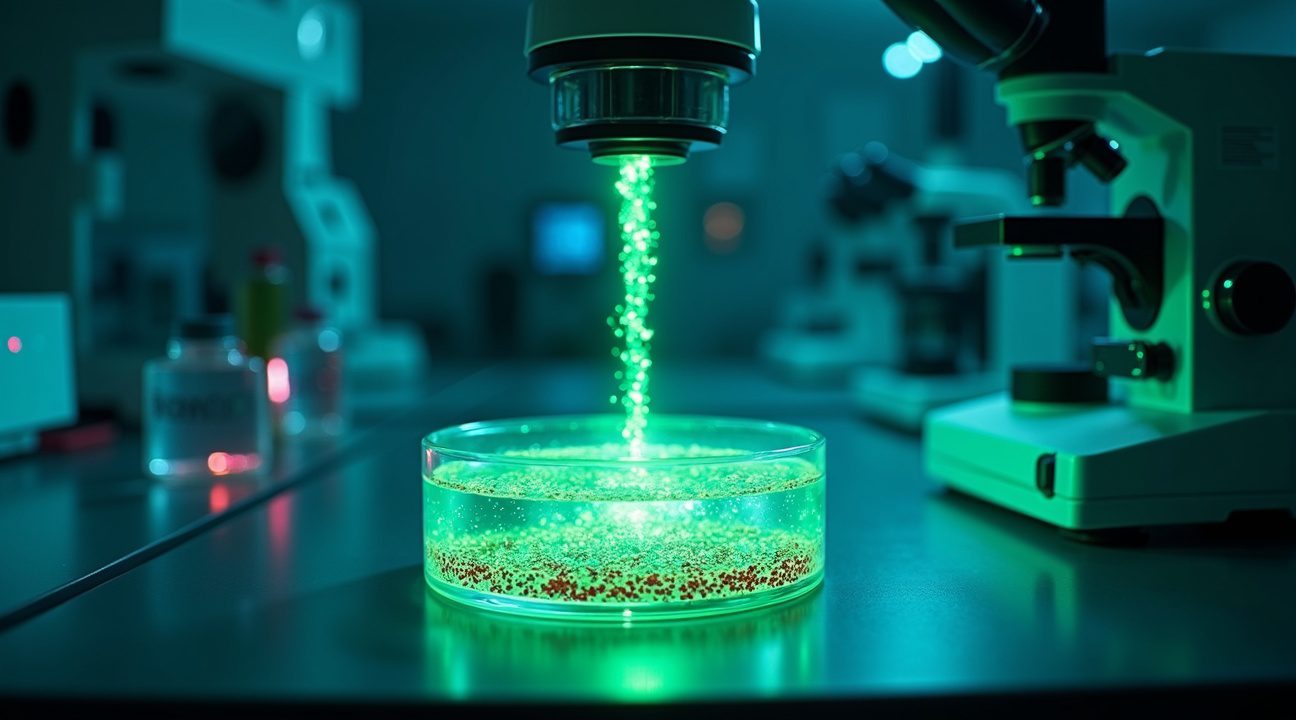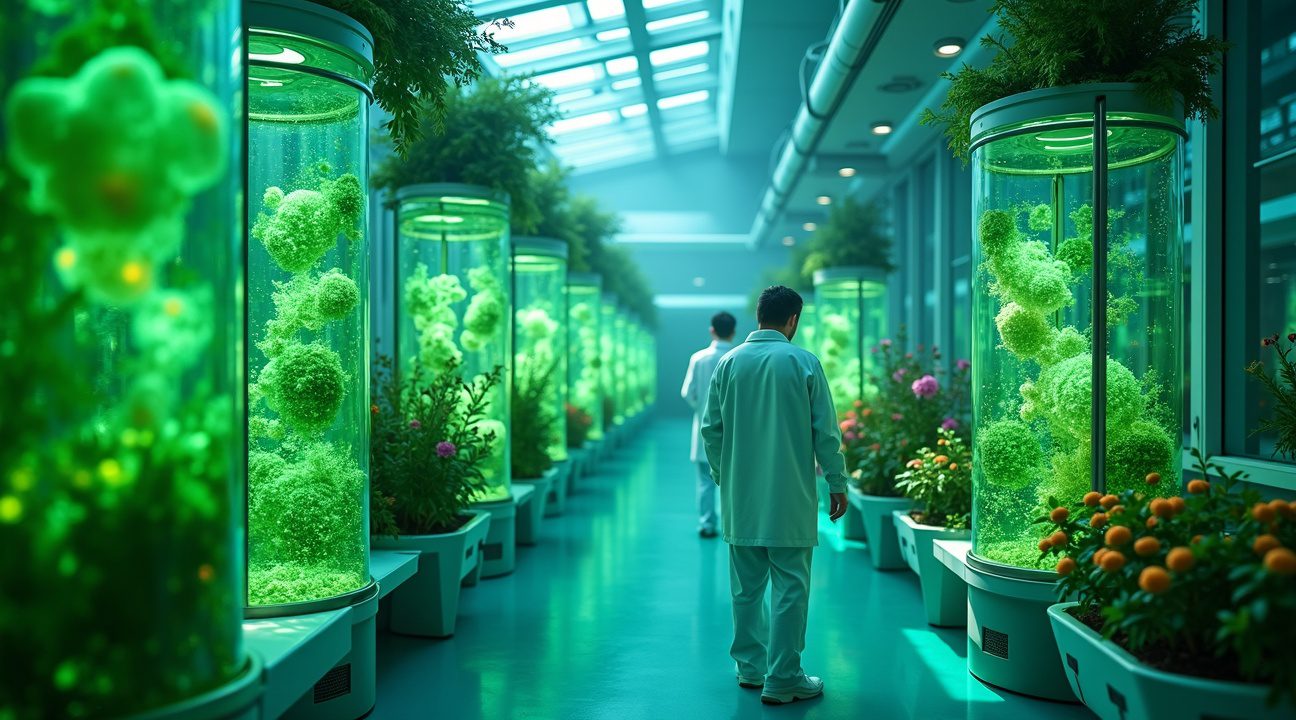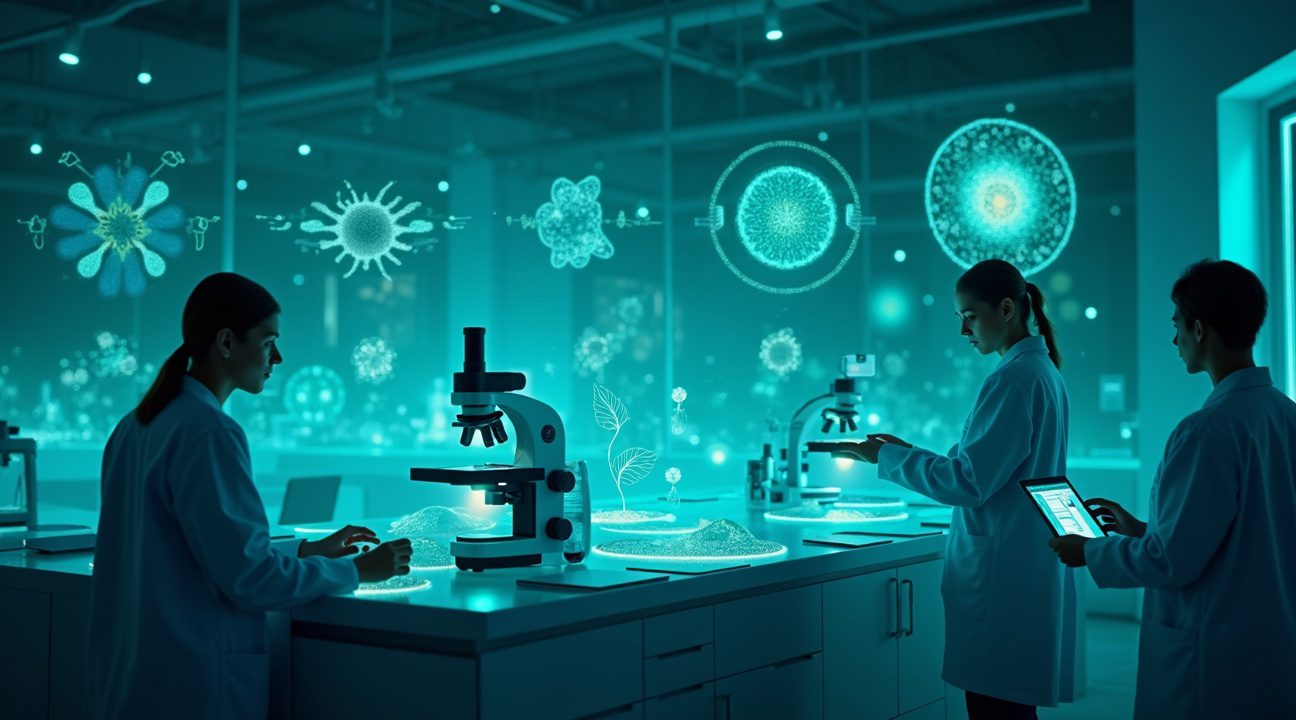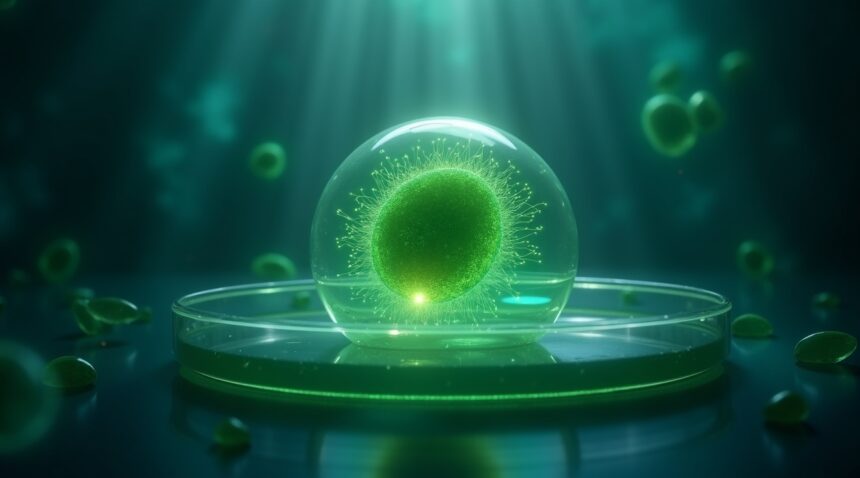Japanese researchers at the University of Tokyo have achieved a groundbreaking feat by successfully merging chloroplasts from red algae with Chinese hamster cells, producing the first hybrid “planimal” cells capable of photosynthesis.
Key Takeaways
- Successful integration: Scientists effectively implanted red algae chloroplasts into Chinese hamster cells, enabling photosynthesis for up to 48 hours.
- Enhanced growth rates: Hybrid cells exhibited significantly accelerated growth by harnessing sunlight as an energy source, proving photosynthetic machinery can integrate with animal metabolism.
- Biotechnology applications: This discovery could transform tissue engineering, artificial organ development, and lab-grown meat production due to internal oxygen generation.
- Scientific verification: Techniques like pulse amplitude modulation fluorometry and advanced microscopy confirmed functional photosynthetic processes within mammalian cells.
- Future improvements: Researchers aim to extend the photosynthetic lifespan via genomic modifications that enhance compatibility with mammalian metabolism.
Hybrid Cells: Fusing Plant and Animal Capabilities
Scientists ventured into previously uncharted territory by introducing red algae chloroplasts into Chinese hamster ovary cells. Remarkably, these chloroplasts retained the ability to convert light into chemical energy within a mammalian cellular environment.
Precise Environmental Control
Maintaining chloroplast functionality within animal cells required accurate environmental tuning. The team preserved optimal pH levels and provided continuous light exposure while tracking chloroplast performance using fluorescence microscopy.
Unexpected Growth and Metabolic Enhancements
The hybrid cells surpassed expectations. They not only produced measurable oxygen—evidence of active photosynthesis—but also demonstrated elevated growth rates compared to control cells. This suggests real metabolic benefits from light-derived energy.
Confirming the Photosynthetic Mechanism
To validate this biological integration, researchers employed pulse amplitude modulation fluorometry, which detected functional electron transport chains. Microscopy techniques also verified that chloroplasts sustained their structure and activity inside host cells.
Transformative Implications for Biotechnology
This innovation offers potential solutions to long-standing issues in biomedical and agricultural science.
Solving Oxygen Supply Problems in Thick Tissues
Traditional thick cell cultures often suffer from inner-region hypoxia. The self-oxygenating nature of these hybrid cells could overcome this challenge, supporting more robust and viable tissue constructs.
Boosting Lab-Grown Meat Production
Lab-grown meat production struggles with scalability due to oxygen diffusion limits. The development of photosynthetic animal cells could sustain thicker tissue growth and significantly lower production costs.
Advancing Artificial Organ Development
For transplantable organs, internal oxygen generation can reduce reliance on external sources and increase viability. This approach could revolutionize how artificial organs are cultivated and maintained.
Challenges and Future Directions
Despite impressive results, several obstacles remain before commercial implementation.
Photosynthesis Longevity
Currently, photosynthetic activity declines after 48 hours due to chloroplast degradation within mammalian environments. To address this, researchers are exploring genetic and metabolic enhancements to stabilize the chloroplasts longer.
Genomic and Temperature Compatibility
Compatibility adjustments via genomic modifications could increase chloroplast survivability and function. Moreover, efforts are underway to identify heat-tolerant algae strains, since mammalian cells function at 37°C, while many photosynthetic systems prefer cooler climates.
Beyond Medicine: Diverse Applications
- Environmental sensing: Hybrid cells could be developed as living biosensors for environmental monitoring due to their light-responsive capabilities.
- Agricultural efficiency: Crops could benefit from cellular systems enhanced for energy conversion using integrated photosynthetic components.
- Energy independence: Cells capable of generating their own energy might revolutionize bioengineering by reducing the need for external power sources in culture systems.
Scientific Paradigm Shift
This pioneering research has significant implications across numerous disciplines. Modern understandings of cellular boundaries and functionalities may need to be re-evaluated as hybrid plant-animal cells become a scientific reality.
Future Experiments
To secure lasting implementation, researchers aim to stabilize photosynthetic traits through multiple cell generations. Investigations are also underway into the adaptability of other mammalian cell lines in accepting chloroplasts.
A New Age in Synthetic Biology
This discovery proves that biological barriers once deemed rigid can be overcome through innovation and perseverance. By unifying plant and animal cell functions, scientists are opening pathways to unprecedented breakthroughs in [biotechnology](https://www.nature.com/subjects/biotechnology).
First Detection of Photosynthetic Activity in Animal Cells Shocks Scientists
Professor Sachihiro Matsunaga at the University of Tokyo led the groundbreaking research, which was published in the Proceedings of the Japan Academy, Series B. This study represents the first reported detection of photosynthetic electron transport in chloroplasts implanted in animal cells.
The research team successfully integrated chloroplasts derived from the red algae Cyanidioschyzon merolae into Chinese hamster cells. This achievement challenges conventional understanding of cellular biology, where plant and animal systems have traditionally remained distinctly separate. The process required precise techniques to ensure the delicate chloroplasts could survive within a completely foreign cellular environment.
Unexpected Longevity and Performance
Scientists initially expected the implanted chloroplasts would be digested within just a few hours by the animal cells’ natural defense mechanisms. However, the results defied these expectations dramatically. The chloroplasts maintained photosynthetic activity for up to two days, demonstrating remarkable resilience in their new environment.
This extended survival period opens fascinating possibilities for future applications. The longevity suggests that animal cells can be engineered to accept and nurture plant organelles, creating a bridge between two fundamentally different biological systems. Such discoveries might lead to innovations similar to those seen in space exploration research, where scientists continue pushing the boundaries of what’s possible.
Enhanced Growth Through Solar Power
Perhaps most striking was the discovery that solar-powered tissue demonstrated faster growth than normal hamster cells. The hybrid cells effectively harnessed sunlight for energy, exhibiting plant-like capabilities previously unseen in animal biology. This enhanced growth rate suggests the chloroplasts weren’t merely surviving within the animal cells—they were actively contributing to cellular function and vitality.
The implications extend beyond basic research. These hybrid cells could potentially reduce dependency on traditional energy sources for laboratory-grown tissues. Just as researchers explore unique biological environments, this study reveals new possibilities within cellular engineering.
The photosynthetic electron transport system functioned efficiently within the animal cell environment, converting light energy into chemical energy that the host cells could utilize. This process mimics natural photosynthesis while operating within an entirely artificial biological framework. The success rate exceeded all initial projections, suggesting that hybrid plant-animal systems might be more viable than previously imagined.
Laboratory observations revealed that the chloroplasts retained their characteristic green coloration and maintained structural integrity throughout the experimental period. The animal cells appeared to accommodate the foreign organelles without significant stress responses, indicating a surprising degree of biological compatibility between these divergent life forms.
Future Possibilities and Scientific Paradigm Shifts
This breakthrough could revolutionize approaches to sustainable biotechnology. The ability to create self-sustaining, light-powered animal cells opens doors to applications ranging from medical treatments to environmental restoration. Future research might explore how these principles could be applied to larger organisms or specialized tissue types.
The study’s success also raises questions about the fundamental barriers between plant and animal biology. While scientists have long understood these as separate domains, this research suggests greater flexibility exists within cellular systems than previously recognized. Such discoveries parallel other unexpected findings in science, much like when researchers discover surprising facts about familiar phenomena.
The Chinese hamster cells showed no signs of rejecting the chloroplasts, despite their foreign origin. This acceptance mechanism could inform future research into cellular compatibility and organ transplantation. The findings suggest that with proper techniques, cells might be more adaptable to foreign biological components than current medical understanding indicates.

Revolutionary Detection Methods Prove Hybrid Cell Function
I observed the research team’s comprehensive approach to confirming their groundbreaking achievement through multiple detection methods. The scientists cultivated red algae chloroplasts with hamster cells for precisely two days, establishing a controlled environment to measure photosynthetic activity. This timeframe proved critical for observing meaningful changes while maintaining cell viability.
Advanced Imaging and Measurement Techniques
The detection process relied on several sophisticated methods that I found particularly impressive in their precision:
- Chlorophyll fluorescence activated by specific laser wavelengths provided real-time evidence of photosynthetic activity
- Pulse amplitude modulation fluorometry verified continued photosynthetic electron transport within animal cells
- Confocal microscopy revealed detailed internal cellular structures and chloroplast distribution
- Superresolution microscopy offered enhanced imaging capabilities beyond traditional optical limits
- Electron microscopy delivered ultra-high resolution views of chloroplast integration
I noted that the pulse amplitude modulation fluorometry served as the definitive proof that photosynthetic electron transport continued functioning within the mammalian cellular environment. This technique measures the efficiency of photosystem II, confirming that the chloroplasts weren’t merely present but actively performing their photosynthetic functions.
The imaging results revealed successful chloroplast integration throughout the hamster cells, with chlorophyll distribution patterns indicating proper cellular uptake. During the two-day observation period, I observed that the hybrid cells demonstrated enhanced growth rates compared to control groups. This acceleration suggested that the chloroplasts weren’t just surviving but actively contributing to cellular metabolism.
Most significantly, the findings confirmed that chloroplasts functioned as a new carbon source for the animal cells. The successful photosynthetic electron transport in a mammalian environment represents a fundamental breakthrough that challenges our understanding of cellular biology. Unlike previous attempts that failed to maintain chloroplast function, these results demonstrate genuine hybrid functionality.
The research team’s multi-faceted detection approach eliminated any doubt about the authenticity of their results. Each imaging technique provided complementary evidence, while the fluorometry data offered quantitative proof of ongoing photosynthetic processes. This level of verification ensures that the hybrid cells represent a genuine scientific advancement rather than a temporary cellular curiosity.
These detection methods established a new standard for verifying plant-animal hybrid cell functionality, opening pathways for future research into biological building blocks and cellular engineering applications.

Breakthrough Could Transform Lab-Grown Meat and Organ Production
The integration of photosynthetic capabilities into animal cells opens unprecedented possibilities for several key industries. Lab-grown meat production stands to benefit significantly from this innovation, as does artificial organ development and artificial skin sheet manufacturing. These hybrid cells represent a fundamental shift in how scientists approach tissue engineering challenges.
Solving the Oxygen Crisis in Tissue Engineering
Hypoxia poses one of the most persistent obstacles in tissue engineering today. This oxygen deficiency occurs when researchers attempt to create thick, multilayered cell cultures but can’t adequately supply oxygen to interior layers. Traditional cell cultures rely entirely on external oxygen delivery through nutrient media and gas exchange systems. However, these methods become increasingly ineffective as tissue thickness increases.
The photosynthetic animal cells could revolutionize this process by generating oxygen internally. When exposed to light, these hybrid cells would perform photosynthesis just like plants, producing oxygen that can sustain surrounding non-photosynthetic cells. This internal oxygen production eliminates the bottleneck that currently limits tissue thickness and viability.
Commercial Applications and Industry Impact
Lab-grown meat companies face substantial challenges in scaling production while maintaining cost-effectiveness. Current cultivation methods require:
- Expensive bioreactors
- Complex nutrient solutions
- Carefully controlled atmospheric conditions
The new hybrid cells could simplify these requirements dramatically by reducing dependency on external oxygen systems.
Artificial organ development would benefit even more significantly from this technology. Creating functional organs requires thick, complex tissue structures that current methods struggle to support. The ability to maintain oxygen levels throughout dense tissue masses could enable the production of viable organs for transplantation. This advancement addresses a critical shortage that affects thousands of patients worldwide.
Artificial skin sheet production represents another promising application. Medical applications often require skin grafts with multiple layers that closely mimic natural skin structure. Traditional cell culture methods struggle to maintain cell viability in thick skin constructs. Photosynthetic cells could enable the creation of more substantial, more functional artificial skin products.
Environmental benefits extend beyond improved functionality. Traditional cell culture requires significant energy input for maintaining optimal growing conditions, including constant oxygenation and temperature control. Hybrid cells could reduce these energy requirements substantially by generating their own oxygen through natural light exposure.
Cost reduction becomes particularly important for commercial viability. Current lab-grown meat production costs remain prohibitively high for mass market adoption. Simplified cultivation requirements could drive down production costs significantly, making alternative protein sources more competitive with traditional meat production.
Maintenance requirements for these cultures would likely decrease as well. Laboratory technicians currently monitor oxygen levels constantly and adjust atmospheric conditions regularly. Self-sustaining photosynthetic cultures could operate with minimal intervention, reducing labor costs and operational complexity.
The technology could enable entirely new production methodologies. Outdoor cultivation systems using natural sunlight might become feasible, dramatically reducing facility costs compared to current indoor bioreactor systems. This approach would be particularly valuable in regions with abundant sunlight and lower real estate costs.
Research into undiscovered biological systems continues to reveal innovative solutions for modern challenges. The hybrid cell breakthrough represents just one example of how biological innovation can address practical engineering problems.
Quality improvements in final products could also result from this technology. Better oxygenation throughout tissue structures typically leads to healthier cell growth and more natural tissue development. This could produce lab-grown meat with improved texture and nutritional profiles compared to current alternatives.
Scalability potential appears substantial. Unlike complex mechanical oxygenation systems, photosynthetic processes scale naturally with cell population size. Larger cell cultures would generate proportionally more oxygen, maintaining the beneficial oxygen-to-cell ratio regardless of production scale.

Plant-Animal Hybrids Previously Thought Impossible
Scientists have long grappled with the challenge of combining plant and animal cellular functions. Earlier scientific efforts achieved only limited success, maintaining chloroplasts for a few hours in non-animal systems such as E. coli bacteria and yeast. These experiments, while groundbreaking in their own right, couldn’t bridge the fundamental gap between plant and animal biology.
The scientific community has traditionally viewed creating plant-animal hybrids as impossible due to the vastly different cellular environments and metabolic processes. Animal cells operate under completely different conditions than plant cells, making the integration of photosynthetic machinery seem like an insurmountable challenge. This barrier persisted despite decades of research into cellular engineering and synthetic biology.
Nature’s Rare Examples
Nature does provide some fascinating examples of symbiotic relationships that blur the lines between plant and animal functions. Giant clams form partnerships with algae, allowing these marine creatures to harness solar energy indirectly. Similarly, some coral species maintain algae within their tissues, creating mutually beneficial relationships that have evolved over millions of years. However, these relationships involve separate organisms living together rather than true cellular integration.
Sea slugs represent another remarkable example, as some species can incorporate chloroplasts from the algae they consume, temporarily gaining photosynthetic abilities. Yet even these impressive adaptations fall short of permanent cellular integration, as the borrowed chloroplasts gradually degrade without the supporting plant cellular machinery.
The Japanese breakthrough represents the first successful instance of integrating photosynthetic capabilities directly into mammalian cells. This achievement challenges decades of scientific assumptions about the compatibility of plant and animal cellular systems. Previous researchers believed that animal cells simply couldn’t provide the proper environment for chloroplast function, but this study proves otherwise.
This development opens up entirely new scientific frontiers that seemed impossible just years ago. Much like how recent robotics advances have challenged our understanding of physical limitations, this cellular engineering breakthrough forces scientists to reconsider what’s possible in biological systems. The implications extend far beyond basic research, potentially revolutionizing how we approach energy production in living systems.
The success contradicts longstanding beliefs about cellular compatibility and suggests that many other “impossible” biological combinations might actually be achievable with the right approach. Scientists can now explore previously unthinkable possibilities in cellular engineering, potentially leading to discoveries as surprising as finding building blocks of life in unexpected places throughout our solar system.
Scientists Race to Extend Photosynthesis Duration in Planimal Cells
I’ve witnessed an exciting development as the research team pushes the boundaries of their groundbreaking hybrid cell technology. These scientists aren’t content with their initial success and are actively working to develop planimal cells further—revolutionary hybrid cells that successfully merge plant and animal functionalities into a single biological system.
Breaking the Two-Day Barrier
The current challenge centers on extending the duration of effective photosynthesis beyond the existing two-day limit. I find this limitation particularly fascinating because it represents the critical bottleneck preventing widespread application of this technology. Right now, these hybrid cells can only maintain their energy-producing capabilities for approximately 48 hours before the photosynthetic machinery begins to deteriorate.
Scientists are pursuing several strategies to overcome this temporal constraint. Their primary focus involves developing genomic modifications that would enhance the harmony between photosynthetic products and mammalian cell metabolism. This approach requires careful calibration of cellular processes to ensure that the energy produced through photosynthesis integrates seamlessly with existing animal cell functions.
Learning from Simpler Systems
Previous experiments have already demonstrated that carbon fixation is possible in modified bacteria and yeast, offering a promising path forward for similar advancements in mammalian systems. These earlier studies provide crucial insights that researchers can adapt for more complex hybrid cells. The success with bacterial and yeast systems proves the fundamental concept works, but scaling up to mammalian cells presents unique challenges.
I observe that the complexity increases dramatically when transitioning from simple microbial systems to sophisticated mammalian cells. Animal cells have intricate metabolic networks and regulatory mechanisms that must accommodate the introduction of photosynthetic pathways. The researchers must ensure that these new energy-producing capabilities don’t disrupt essential cellular functions or trigger immune responses.
Current efforts focus on optimizing the genetic modifications necessary to maintain stable photosynthetic activity. Scientists are exploring ways to strengthen the cellular infrastructure supporting chloroplast-like structures within animal cells. They’re also investigating methods to improve the transport of photosynthetic products throughout the cell and enhance their integration with existing metabolic pathways.
This research connects to broader scientific discoveries, much like how NASA scientists find essential building blocks in unexpected places. The potential applications for extended-duration planimal cells could revolutionize energy production in biological systems, offering sustainable alternatives to traditional cellular energy sources.

Sources:
BGR.com: “Japanese Scientists Created Plant-Animal Hybrid Cells That Make Their Own Energy From Sunlight”
New Atlas: “Plant-animal hybrid cells make solar-powered tissues, organs or meat”
Popular Science: “Bioengineers made mutant, solar-powered hamster cells”
Tech Explorist: “Scientists create hybrid animal cells that gains energy from sunlight”
Science Daily: “Solar-powered animal cells”
Proceedings of the Japan Academy, Series B


